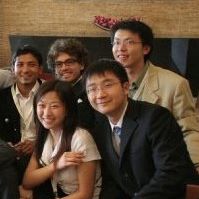Ji Gang Li
age ~46
from Clifton Park, NY
- Also known as:
-
- Ji G Li
- Jigang C Li
- Jgang Li
- Li Ji Gang
- Li Jigang
- Li Qin
Ji Li Phones & Addresses
- Clifton Park, NY
- Rensselaer, NY
- Sunnyvale, CA
- San Jose, CA
- Lincoln, NE
Lawyers & Attorneys

Ji Li - Lawyer
view sourceAddress:
Beijing Zhonglun Law Firm
(015)8011227 (Office)
(015)8011227 (Office)
Licenses:
New York - Currently registered 2011
Education:
The College of Williamm

Ji Liz Li - Lawyer
view sourceLicenses:
California - Active 2002
Education:
University of Minnesota
University of Minnesota Law School
University of Minnesota Law School
Us Patents
-
Apparatus And Method For Measuring A Property Of A Layer In A Multilayered Structure
view source -
US Patent:6958814, Oct 25, 2005
-
Filed:Mar 1, 2002
-
Appl. No.:10/090316
-
Inventors:Peter G. Borden - San Mateo CA, US
Ji Ping Li - Fremont CA, US -
Assignee:Applied Materials, Inc. - Santa Clara CA
-
International Classification:G01N021/55
G01N021/88 -
US Classification:356432, 356445, 3562372
-
Abstract:An apparatus measures a property of a layer (such as the sheet resistance of a conductive layer) by performing the following method: (1) focusing the heating beam on the heated a region (also called “heated region”) of the conductive layer (2) modulating the power of the heating beam at a predetermined frequency that is selected to be sufficiently low to ensure that at any time the temperature of the optically absorbing layer is approximately equal to (e. g. , within 90% of) a temperature of the optically absorbing layer when heated by an unmodulated beam, and (3) measuring the power of another beam that is (a) reflected by the heated region, and (b) modulated in phase with modulation of the heating beam. The measurement in act (3) can be used directly as a measure of the resistance (per unit area) of a conductive pad formed by patterning the conductive layer. Acts (1)-(3) can be repeated during fabrication of a semiconductor wafer, at each of a number of regions on a conductive layer, and any change in measurement indicates a corresponding change in resistance of the layer.
-
Apparatus And Method For Measuring A Property Of A Layer In A Multilayered Structure
view source -
US Patent:7141440, Nov 28, 2006
-
Filed:May 2, 2005
-
Appl. No.:11/120427
-
Inventors:Peter G. Borden - San Mateo CA, US
Ji Ping Li - Fremont CA, US -
Assignee:Applied Materials, Inc. - Santa Clara CA
-
International Classification:H01L 21/00
-
US Classification:438 5, 438 7, 438 10, 438 17, 3562375
-
Abstract:A property of a layer is measured by: (1) focusing a heating beam on a region (also called “heated region”) of a conductive layer (2) modulating the power of the heating beam at a predetermined frequency that is selected to be sufficiently low to ensure that at any time the temperature of an optically absorbing layer is approximately equal to (e. g. , within 90% of) a temperature of the optically absorbing layer when heated by an unmodulated beam, and (3) measuring the power of another beam that is (a) reflected by the heated region, and (b) modulated in phase with modulation of the heating beam. The measurement in act (3) can be used directly as a measure of the resistance (per unit area) of a conductive pad formed by patterning the conductive layer. Change in measurement across regions indicates a corresponding change in resistance of the layer.
-
Optical Communications Using Multiplexed Single Sideband Transmission And Heterodyne Detection
view source -
US Patent:7146103, Dec 5, 2006
-
Filed:Jul 30, 2001
-
Appl. No.:09/918886
-
Inventors:Ting K Yee - Foster City CA, US
Peter H Chang - San Jose CA, US
Shin-Sheng Tarng - San Jose CA, US
Gregory M Cutler - Cupertino CA, US
Slava Yazhgur - Daly City CA, US
Ji Li - Cupertino CA, US
Laurence J Newell - Saratoga CA, US
James F Coward - Los Gatos CA, US
Michael W Rowan - Los Gatos CA, US
Norman L Swenson - Fremont CA, US
Matthew C Bashaw - Palo Alto CA, US -
Assignee:Forster Energy LLC - Las Vegas NV
-
International Classification:H04J 14/02
H04J 1/00
H04J 1/04
H04J 1/08
H04B 10/04
H04B 10/05
H04B 10/08
H04B 10/145
H04B 10/148 -
US Classification:398 68, 398 76, 398 82, 398 91, 398 95, 398152, 398163, 398184, 398196, 398205
-
Abstract:A transmitter subsystem generates an optical signal which contains multiple subbands of information. The subbands have different polarization. For example, in one approach, two or more optical transmitters generate optical signals which have different polarization. An optical combiner optically combines the optical signals into a composite optical signal for transmission across an optical fiber. In another aspect, each optical transmitter generates an optical signal containing both a lower optical sideband and an upper optical sideband (i. e. , a double sideband optical signal). An optical filter selects the upper optical sideband of one optical signal and the lower optical sideband of another optical signal to produce a composite optical signal.
-
Optical Transceiver Using Heterodyne Detection And A Transmitted Reference Clock
view source -
US Patent:7346279, Mar 18, 2008
-
Filed:Mar 25, 2002
-
Appl. No.:10/107085
-
Inventors:Ji Li - San Jose CA, US
Laurence J. Newell - Mercer Island WA, US
Tin Vo - San Jose CA, US
Ting K. Yee - Foster City CA, US
Peter H. Chang - San Jose CA, US
Robert K. McElheny - Sunnyvale CA, US -
Assignee:Forster Energy LLC - Las Vegas NV
-
International Classification:H04B 10/08
H04B 10/00 -
US Classification:398 32, 398155
-
Abstract:A heterodyne communication system uses coherent data modulation that is resistant to phase noise. In particular, a pilot tone and reference clock signal are transmitted along with the modulated data to form the basis of an electrical demodulation local oscillator at the receiver. The pilot tone and/or reference clock signal carry phase noise which is correlated with the phase noise in the data signal. At the receiver, the local oscillator is generated from the pilot tone and reference clock signal in a manner so that the local oscillator also has phase noise which is correlated with the phase noise in the data signal. Thus, the two noise components can be used to cancel each other during demodulation of the data signal using the local oscillator.
-
Optical Communications Using Multiplexed Single Sideband Transmission And Heterodyne Detection
view source -
US Patent:7447436, Nov 4, 2008
-
Filed:Aug 31, 2006
-
Appl. No.:11/514381
-
Inventors:Ting K. Yee - Foster City CA, US
Peter H. Chang - San Jose CA, US
Chin-Sheng Tarng - San Jose CA, US
Gregory M. Cutler - Cupertino CA, US
Slava Yazhgur - Daly City CA, US
Ji Li - Cupertino CA, US
Laurence J. Newell - Saratoga CA, US
James F. Coward - Los Gatos CA, US
Michael W. Rowan - Los Gatos CA, US
Norman L. Swenson - Fremont CA, US
Matthew C. Bradshaw - Palo Alto CA, US -
Assignee:Forster Energy LLC - Las Vegas NV
-
International Classification:H04B 10/08
H04B 10/04
H04B 10/06
H04B 10/145
H04B 10/148
H04J 14/02
H04J 1/00
H04J 1/04
H04J 1/08 -
US Classification:398 95, 398 68, 398 82, 398 91, 398152, 398163, 398184, 398196, 398205
-
Abstract:A transmitter subsystem generates an optical signal which contains multiple subbands of information. The subbands have different polarizations. For example, in one approach, two or more optical transmitters generate optical signals which have different polarizations. An optical combiner optically combines the optical signals into a composite optical signal for transmission across an optical fiber. In another aspect, each optical transmitter generates an optical signal containing both a lower optical sideband and an upper optical sideband (i. e. , a double sideband optical signal). An optical filter selects the upper optical sideband of one optical signal and the lower optical sideband of another optical signal to produce a composite optical signal.
-
Optical Transceiver Using Heterodyne Detection And A Transmitted Reference Clock
view source -
US Patent:7620318, Nov 17, 2009
-
Filed:Jan 14, 2008
-
Appl. No.:12/014019
-
Inventors:Ji Li - San Jose CA, US
Laurence J. Newell - Mercer Island WA, US
Tin Vo - San Jose CA, US
Ting K. Yee - Foster City CA, US
Peter H. Chang - San Jose CA, US
Robert K. McElheny - Sunnyvale CA, US -
International Classification:H04B 10/08
H04B 10/00 -
US Classification:398 32, 398155
-
Abstract:A heterodyne communication system uses coherent data modulation that is resistant to phase noise. In particular, a pilot tone and reference clock signal are transmitted along with the modulated data to form the basis of an electrical demodulation local oscillator at the receiver. The pilot tone and/or reference clock signal carry phase noise which is correlated with the phase noise in the data signal. At the receiver, the local oscillator is generated from the pilot tone and reference clock signal in a manner so that the local oscillator also has phase noise which is correlated with the phase noise in the data signal. Thus, the two noise components can be used to cancel each other during demodulation of the data signal using the local oscillator.
-
Machine Learning-Powered Framework To Transform Overloaded Text Documents
view source -
US Patent:20220414315, Dec 29, 2022
-
Filed:Jul 21, 2022
-
Appl. No.:17/870412
-
Inventors:- Redmond WA, US
Ji LI - San Jose CA, US -
International Classification:G06F 40/114
G06F 40/151
G06N 20/00
G06F 40/106
G06F 40/186 -
Abstract:Systems and methods for providing a machine learning-powered framework to transform overloaded text documents is provided. The system generates a plurality of candidate templates offline. During runtime, the system accesses a text document and analyzes the text document to identify segmentation data. The segmentation data can indicate a plurality of segments derived from the text document. The system then accesses a plurality of candidate templates, whereby each candidate template comprises a plurality of pages having a different background element that shares a common theme. The plurality of candidate templates are ranked based on at least the segmentation data. The network then generates multiple presentation pages for each of a predetermined number of top ranked candidate templates by incorporating each of the plurality of segments into a corresponding page of the plurality of pages for each of the top ranked candidate templates. The multiple presentation pages are presented for each of the top ranked candidate templates as a recommendation.
-
Smart Summarization, Indexing, And Post-Processing For Recorded Document Presentation
view source -
US Patent:20220415365, Dec 29, 2022
-
Filed:Jun 23, 2021
-
Appl. No.:17/355634
-
Inventors:- Redmond WA, US
Ji LI - San Jose CA, US -
International Classification:G11B 27/10
G06K 9/00
G06F 40/134
G06F 3/0482
G06K 9/62
G10L 15/22
G10L 15/26
G06F 40/279
G10L 25/57
G06F 16/43
G06N 20/00 -
Abstract:Systems and methods for providing summarization, indexing, and post-processing of a recorded document presentation are provided. The system accesses a structured document and recordings associated with a recorded presentation given using the structured document. The system analyzes, using machine-trained models, the structured document, audio and video recordings, and recording of operations performed during the presentation. The analyzing comprises generating a transcript of the audio recording, determining context of components of the structured document, and deriving context from the video recordings and recording of operations. Based on the analyzing, the system segments the recorded presentation into a plurality of segments and generates an index of the plurality of segments that is used for post-processing.
Name / Title
Company / Classification
Phones & Addresses
President
GALAXY POLYTHENE INC
1046 Otis Dr, Alameda, CA 94501
Managing
Green Energy Investment LLC
Real Estate Investment · Investor
Real Estate Investment · Investor
1446 E Calaveras Blvd, Milpitas, CA 95035
Medicine Doctors

Ji Li
view sourceSpecialties:
Anesthesiology, Pain Management
Work:
Applied Pain Institute LLC
1015 S Mercer Ave, Bloomington, IL 61701
(309)6620088 (phone), (309)6620089 (fax)
1015 S Mercer Ave, Bloomington, IL 61701
(309)6620088 (phone), (309)6620089 (fax)
Education:
Medical School
Capital Univ of Med Scis, Training Ctr of Gen Prac, Beijing City, China
Graduated: 1983
Capital Univ of Med Scis, Training Ctr of Gen Prac, Beijing City, China
Graduated: 1983
Languages:
English
Description:
Dr. Li graduated from the Capital Univ of Med Scis, Training Ctr of Gen Prac, Beijing City, China in 1983. He works in Bloomington, IL and specializes in Anesthesiology and Pain Management.
Resumes

Ji Li
view source
Ji Li
view source
Ji Li
view source
Ji Li
view sourceWork:
Frostburg State University
Student
Student

Ji Li
view source
Ji Dong Li
view source
Ji Li
view source
Ji Li
view sourceLocation:
United States
Googleplus

Ji Li
Work:
Oracle Corporation - SQA (2010)
Sun Microsystems - SQA (2008-2010)
Sun Microsystems - SQA (2008-2010)

Ji Li
Education:
Waseda University

Ji Li

Ji Li

Ji Li

Ji Li

Ji Li

Ji Li
Myspace

Ji Yong Li
view source
Wang Ji Li
view source
Ji Li
view source
Ji Li
view source
Ji Li
view source
Ji Li
view source
Ji Li
view source
Ji Li
view sourceClassmates

Ji Li
view sourceSchools:
Eastern Michigan Un iversity Ypsilanti MI 1999-2003
Community:
Marty Spalding, Tom Smith, Gary Duszynski

ji li | John H. Francis P...
view source
John H. Francis Polytechn...
view sourceGraduates:
juan macias (1983-1987),
ji li (1986-1990),
Vicki Black (1955-1959),
Eric Schwartz (1963-1967),
Amy Jacobs (1967-1971),
Andrew Zicari (1971-1975)
ji li (1986-1990),
Vicki Black (1955-1959),
Eric Schwartz (1963-1967),
Amy Jacobs (1967-1971),
Andrew Zicari (1971-1975)

Eastern Michigan Un ivers...
view sourceGraduates:
Ji Li (1999-2003),
Gianina DeLaurentiis (1997-2002),
Curtis Baker (1992-1996),
Tracey Davenport (1988-1992)
Gianina DeLaurentiis (1997-2002),
Curtis Baker (1992-1996),
Tracey Davenport (1988-1992)

Rendafu High School, Beij...
view sourceGraduates:
LI Ji (1976-1980),
LI Huang (1988-1992),
Weisheng Wa (1989-1993),
Tiebang Wang (1971-1975),
Feng He (1999-2003),
Yikun Ban (2000-2004),
LI An (1991-1995)
LI Huang (1988-1992),
Weisheng Wa (1989-1993),
Tiebang Wang (1971-1975),
Feng He (1999-2003),
Yikun Ban (2000-2004),
LI An (1991-1995)
Youtube
Flickr
Plaxo

ji li
view sourceLG 共产党员

LI Ji
view sourceShenzhen, China

Ji Li
view sourceHarbin Institute of Technology

Ji Li C.P.M.
view sourcePortland, Oregon, U.S.A.
Get Report for Ji Gang Li from Clifton Park, NY, age ~46














